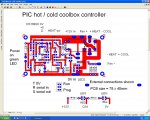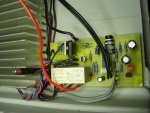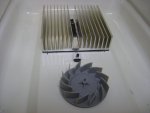I developed this idea from CPEDW's project for a boat fridge controller, the aim being to control both the cooling and heating of my Peltier coolbox.
Being new to PIC's I am struggling with the heating bit so hopefully one of you will be able to help.
Outline description : as CPEDW I am checking the battery voltage first but only to see that it is above 11.9volts (PIC pin6)
Check to see if a switch on PIC pin 4 is operated (heating) or not (cooling)
If switch is closed operate a polarity changeover relay to reverse connections to the Peltier unit
Read the input from DS18B20 in PIC pin 3
Output PIC pin 7 to a high power Ultra FET transistor (=virtually zero on resistance)
The problem I am having is that when on heating, the relay releases when the hitemp value is reached
I am suspecting that I have made errors around line 50 as I can't get my head around the way it decodes the temperature values..I have read and re-read PICAXE manual 2 section 2 page 128 but I still cant grasp it.....how about an Excel sheet with the temp vs values on ????
I have attached the listing together with a circuit diagram
thanks in anticipation
Being new to PIC's I am struggling with the heating bit so hopefully one of you will be able to help.
Outline description : as CPEDW I am checking the battery voltage first but only to see that it is above 11.9volts (PIC pin6)
Check to see if a switch on PIC pin 4 is operated (heating) or not (cooling)
If switch is closed operate a polarity changeover relay to reverse connections to the Peltier unit
Read the input from DS18B20 in PIC pin 3
Output PIC pin 7 to a high power Ultra FET transistor (=virtually zero on resistance)
The problem I am having is that when on heating, the relay releases when the hitemp value is reached
I am suspecting that I have made errors around line 50 as I can't get my head around the way it decodes the temperature values..I have read and re-read PICAXE manual 2 section 2 page 128 but I still cant grasp it.....how about an Excel sheet with the temp vs values on ????
I have attached the listing together with a circuit diagram
thanks in anticipation
Attachments
-
2.8 KB Views: 50
-
83.9 KB Views: 164
Last edited:






